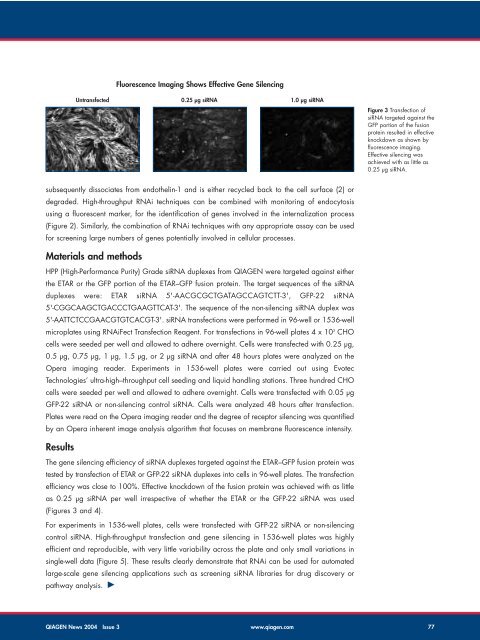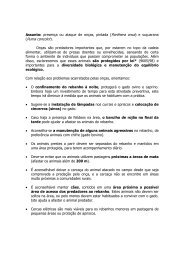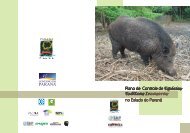QIAGEN News - Rede Pró-Fauna
QIAGEN News - Rede Pró-Fauna
QIAGEN News - Rede Pró-Fauna
You also want an ePaper? Increase the reach of your titles
YUMPU automatically turns print PDFs into web optimized ePapers that Google loves.
subsequently dissociates from endothelin-1 and is either recycled back to the cell surface (2) or<br />
degraded. High-throughput RNAi techniques can be combined with monitoring of endocytosis<br />
using a fluorescent marker, for the identification of genes involved in the internalization process<br />
(Figure 2). Similarly, the combination of RNAi techniques with any appropriate assay can be used<br />
for screening large numbers of genes potentially involved in cellular processes.<br />
Materials and methods<br />
HPP (High-Performance Purity) Grade siRNA duplexes from <strong>QIAGEN</strong> were targeted against either<br />
the ETAR or the GFP portion of the ETAR–GFP fusion protein. The target sequences of the siRNA<br />
duplexes were: ETAR siRNA 5'-AACGCGCTGATAGCCAGTCTT-3', GFP-22 siRNA<br />
5'-CGGCAAGCTGACCCTGAAGTTCAT-3'. The sequence of the non-silencing siRNA duplex was<br />
5'-AATTCTCCGAACGTGTCACGT-3'. siRNA transfections were performed in 96-well or 1536-well<br />
microplates using RNAiFect Transfection Reagent. For transfections in 96-well plates 4 x 103 CHO<br />
cells were seeded per well and allowed to adhere overnight. Cells were transfected with 0.25 µg,<br />
0.5 µg, 0.75 µg, 1 µg, 1.5 µg, or 2 µg siRNA and after 48 hours plates were analyzed on the<br />
Opera imaging reader. Experiments in 1536-well plates were carried out using Evotec<br />
Technologies’ ultra-high–throughput cell seeding and liquid handling stations. Three hundred CHO<br />
cells were seeded per well and allowed to adhere overnight. Cells were transfected with 0.05 µg<br />
GFP-22 siRNA or non-silencing control siRNA. Cells were analyzed 48 hours after transfection.<br />
Plates were read on the Opera imaging reader and the degree of receptor silencing was quantified<br />
by an Opera inherent image analysis algorithm that focuses on membrane fluorescence intensity.<br />
Results<br />
Fluorescence Imaging Shows Effective Gene Silencing<br />
Untransfected 0.25 µg siRNA<br />
1.0 µg siRNA<br />
The gene silencing efficiency of siRNA duplexes targeted against the ETAR–GFP fusion protein was<br />
tested by transfection of ETAR or GFP-22 siRNA duplexes into cells in 96-well plates. The transfection<br />
efficiency was close to 100%. Effective knockdown of the fusion protein was achieved with as little<br />
as 0.25 µg siRNA per well irrespective of whether the ETAR or the GFP-22 siRNA was used<br />
(Figures 3 and 4).<br />
For experiments in 1536-well plates, cells were transfected with GFP-22 siRNA or non-silencing<br />
control siRNA. High-throughput transfection and gene silencing in 1536-well plates was highly<br />
efficient and reproducible, with very little variability across the plate and only small variations in<br />
single-well data (Figure 5). These results clearly demonstrate that RNAi can be used for automated<br />
large-scale gene silencing applications such as screening siRNA libraries for drug discovery or<br />
pathway analysis.<br />
Figure 3 Transfection of<br />
siRNA targeted against the<br />
GFP portion of the fusion<br />
protein resulted in effective<br />
knockdown as shown by<br />
fluorescence imaging.<br />
Effective silencing was<br />
achieved with as little as<br />
0.25 µg siRNA.<br />
<strong>QIAGEN</strong> <strong>News</strong> 2004 Issue 3 www.qiagen.com 77







